|
Our first foray into the animal world of course starts with chickens. Most laymen farmers/homesteaders start off
with chickens as these things are probably the easiest animals to take care of next to rabbits and don't really require a
lot of room and give you a lot of benefits in the form of eggs every so often along with meat on occasion.
Being the po' folks that we are, we had to do things with frugality in mind, meaning we wanted to spend as little as
humanly possible while still accomplishing the goal. In this case we bought chicks locally. It was a lot cheaper
and more personal than ordering chicks thru the mail (you don't get to look at the product before buying, and some may not
survive the trip).
Of course since we started this adventure in the trailing end of winter, we couldn't just pop up a dog house in the yard
and stick some tiny chickens out there and expect them to survive, nope, they had to come in the house with us. This
was OK in the beginning of course, when they were pretty small. We started off with 3 Black Japanese Bantams, which
were small to start with and don't really grow big at all, their adult size is about par with 1 month old Rhode Island Red,
which we'll get to in a moment.
These little chickens hung out in a box in the middle of the living room floor with a light fixture clamped to the side
of the box to help keep em warm. Chicks need a temp around the 90 degree range to keep them happy. They'll let
you know whether they're hot or cold. If they huddle under the lamp, they're freezin', and if they're spread out away
from the center of the light beam, they're letting you know they don't wanna become little rotisserie chickens before their
time, like I said, pretty easy to deal with. Other than that, a couple of feeders for water and starter feed, which
was reasonably cheep, I mean cheap, at $13 for a 50lb bag, kept these little chicks alive.
Unfortunately one of the bantams did die, and after having a service for him, which was nothing more than a prompt burial
in the pet cemetery, we started looking for more chicks, can't do anything with 2 chickens now, especially when their eggs
will be rather small. After a search, we turned up another chicken farmer who had some month old Rhode Island Reds for
a reasonable price. We ended up getting 3 hens and the lady threw in a rooster for free since she had too many.
Imagine what those 2 little bantams thought when this foursome showed up, crowding them out. Luckily they did get along.
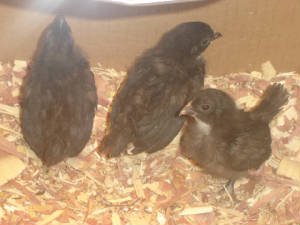
|
| The trio of Black Japanese Bantams in their infancy |
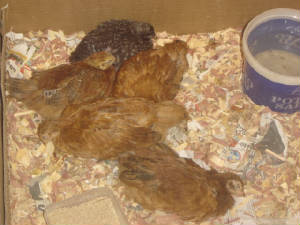
|
| The Rhode Island Reds, resting with one of the bantams |
For the next few months the three bantams and four reds lived in harmony in a larger box. We also added a Barred
Rock chicken to the mix as well, same age as the others. She adjusted pretty fast, mainly because everyone was still
young. This kind of practice would proove to be more difficult after the chickens reach maturity. After
a while they started jumping to the top of the box to roost. We ended up having to put plastic pet food bags around
the bottom of the box to keep the chicken shit from staining and sticking to the rug. Granted this was a rather nasty
phase in the world of chicken raising as we had to constantly clean this stuff up.
At this point we immediately started building a chicken tractor to house these stinky bastards when they got big enough
and the weather broke enough that they wouldn't freeze. We built a chicken tractor with the intent of being able to
move the whole works periodically while still keeping the birds protected from the "real world". We didn't know if our
dogs would be a problem or if every animal in the woods would suddenly materialize once some vulnerable chickens found themselves
roaming around free. The tractor is around 8 ft long, 4 ft high and 3 ft wide. The coop area has these dimensions
with the exception of its 3 ft length. We installed a set of nesting boxes totalling 4 individual boxes and a single
roosting post in the middle of the enclosure. We also installed a light fixture in the ceiling of the coop, more for
inducing the chickens' laying instinct through light exposure than for heat, but in the winter, an incandescent light can
still take some of the chill from the enclosure.
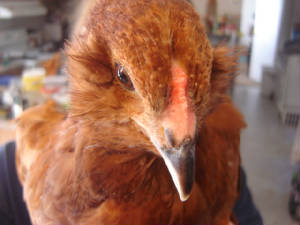
|
| RIR hen posing for a closeup |
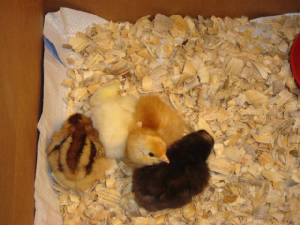
|
| Mutt Chickens joining the flock |
Once the birds got big enough, out they went!! But of course, since the chicken bug bit us, we had to have more,
especially when the lady we got our eggs from told us she hatched a batch of what I like to call "mutt chickens". They
were mixes of Lord knows what but were still larger breeds so they will at least be able to compare with the Reds. We
bought four of these mutt chickens and recycled the box from the first batch. The cycle begins all over again.
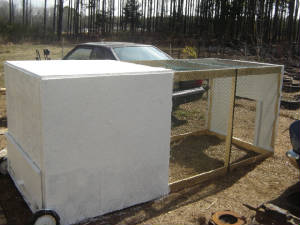
|
| Chicken tractor under construction |

|
| Nesting boxes of chicken tractor |
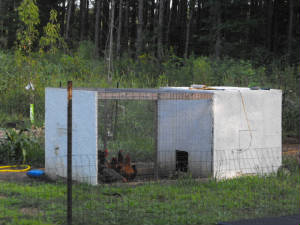
|
| Chicken tractor in its new location |
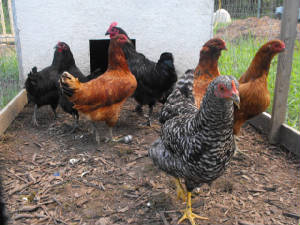
|
| Grown up chickens inside chicken tractor |
While the first generation chickens enjoyed their new residence, we ended up actually picking up a trio of chickens,
a rooster and two hens that are a mix with Buff Orpingtons. These birds were the same age as the first gen chickens,
about 5 months old at the time. There wasn't any problem with this trio being assimilated into the flock, for two reasons.
First reason was during a test run of the chicken tractor, we only put one layer of normal chicken wire on the run and
put the Red rooster and a Red hen in the tractor for the day, only to come back and find the chicken wire torn open and the
chickens out. We only found the hen, the rooster, a no show. We figured that one of my mom's dogs tore the thing
open trying to get to the chickens. At that point we made repairs and added another layer of heavier welded wire on
top of the chicken wire, so any animal will have to work to get into that thing.
Needless to say we ended up moving the tractor to an area next to the garden and fencing in the entire area, so all of
this almost didn't matter, since we let the chickens out during the day to roam the fenced in area. Otherwise, when
we put the trio of chickens in the coop, they adjusted fast, probably because of the rooster coming in and asserting his dominance
over the flock. The 3 larger black chickens are the new additions to the tractor.
At this point we decided to start building a larger coop, a more permanent fixture in the chicken yard in order to accomodate
the 2nd generation chickens along with the 1st gen birds. This coop was situated on a 4x8 plywood board and would be
4ft high to allow for headroom for us when we go to clean the thing out. It will have two tiers of nesting boxes and
two roosting posts and a large entry door that would be enough for even one of us to crawl into.
With plywood sides, and a tar paper/steel roof, this thing should last a while. Its suspended on masonry blocks
to keep the base from rotting due to moisture, and to serve as a barrier from rodent infiltration.
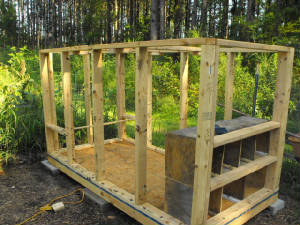
|
| Larger chicken coop under construction |
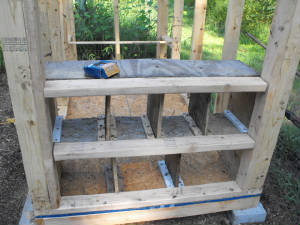
|
| Nesting boxes set up in coop |
We have the coop almost done at this point, walls, most of the roof steel, entry ramp, caulking, all done. We still
have to put one piece of roof steel up, we got a couple of sheets from a neighbor for nothing, but wasn't enough, need that
one piece. The caulking was done to seal the whole thing up, and a ramp put on. Nesting box lids were attached
when that wall went up. Right now only one roosting post is up, still have to get one more piece of wood for the 2nd
one.
We still have to paint the whole coop, but that will come soon enough. The main thing was moving everybody into
their new home. This was best done at night when everybody was half asleep and less prone to fighting back. We
removed the 1st gen birds from the tractor and dumped them inside, then took the 2nd gens from the house and placed them in
and shut them all in. The following morning, everyone appeared like they went into one of those weird mental universe
time warps, where they woke up in another world. Taking away that "this is my turf" mentality that's established by
the 1st flock into a coop, no one got into any fights.
UPDATE:
While the 1st gen chickens were outside, we did lose two more bantams to the heat. We did have to clip the wings
of three of the chickens due to the idea they kept flying up to the entry gate and escaping into the yard. While this
wasn't a problem at first when they hung around the front of the house with the dogs, which surprisingly don't mind the birds,
but now they start roaming farther and farther from the house. After clipping the feathers off of their wings, that
problem disappeared.
Another problem that has happened was that some of the chickens we had inside started getting sick and weak before finally
dying. We don't know what caused this but we lost several chickens already. We only lost one of the 1st gen chickens
and that was one of the ones we clipped the wings on, which the stress from that probably added to whatever was already ailing
the bird. Everybody else is still doing pretty good.
Because of these losses we ended up looking for more chickens. We did get a free Grey Japanese bantam from another
lady we get eggs from since she didn't have the room in her pen for the hen. At the same time we acquired three Auracana
hens that are 2 months old from another guy and three Polish something or another chickens. The Polishes are wild looking,
they have this funny feather hairstyle that almost looks like an Afro, I nicknamed them Afro-chickens cuz of that (I'm half
black y'all so there aint no racism in that statement). Anyway the Auracanas, Polishes, the Grey Jap and even the Black
Jap bantam from the 1st gen set all went into the chicken tractor as their own isolated flock. They're all doing well
so at this point we'll see how things go. The weather's starting to break now so the birds don't have to worry about
getting cooked to death as much now.
UPDATE 5-23-12:
Its been a while since our foray into the chicken farming hobby and many things
have went down. While we did have a lot of chickens die on us over the course of 9 months, we've also been replacing
them too. During the winter months we bought many chicks from Ideal Poultry and raised them in brooder boxes in the
house. Some died along the way but many made it to adulthood.
In those batches of birds
we also purchased some ducks. We started off with Peking ducks, adding to the 4 ducks we already acquired the past fall
from a local seller. One of those poor ducks is a little gimpy with a foot that's curved inward, causing him to walk
or more like waddle rather amusingly, we bought more pekings from the hatchery in case this one didnt make it for some reason.
Surprisingly this duck is still going strong, even being able to move pretty fast despite his handicap.
At
this point, we have somewhere around 15 ducks of different species, some were from the hatchery and some were from the local
co-ops, most are adults or "teenagers" at this point. We have the pekings, mallards, rouens, Chinese crested, and Swedish
ducks.
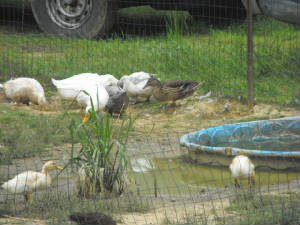
|
| Shot of the ducks playing around their kiddie pool |
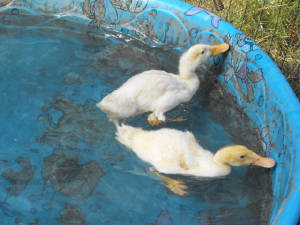
|
| Closeup of young Peking ducks in pool |
We have the ducks penned up in the old area where we initially raised all the chickens, due to the fact that we did lose
a couple of ducks to unknown predators overnight. To be safe we keep them penned up for the time. We dug a hole
and placed a kiddie pool in it and filled it with water for the ducks to wade in. The only chickens that go in the penned
in area are the adolescent chickens that are transferred from the brooder boxes in the house. The adult chickens are
allowed to free range around the yard and house. They'll roost just about anywhere, but usually roosting on the porch,
which will have to stop because neither one of us feels like spraying down the porch everyday to remove chicken shit.
Another addition to the flock is a batch of Thai Game Chickens that were given to us by one of my co-workers. All of
these birds are adults with an almost even split between roosters and hens, leaning more towards roosters. These birds
were for the most part not too bad as far as getting along with the other chickens but a few had the inclination to violence
at times, with a couple of our younger birds being found dead, along with a couple of sightings of them picking on the smaller
birds too. As far as the adult birds, the other roosters would sometimes challenge them or they would just pick on each
other, we would find some of the birds missing feathers from time to time.
After a while
we decided that a couple of the more scrappy roosters had to go, so we had our first shot in butchering chickens. We
set up our propane turkey fryer for dipping the carcass and put a flower pot shepherd's hook in the ground. We took
each bird and wire tied his feet together and hung him upside down while I took a sharp knife and slit his throat to let him
bleed out. Afterward, his head came off, he got dipped, plucked, gutted and put in the freezer until we fried him, or
them. They were indeed pretty good, not only because of them being free range birds but also because we had an almost
complete involvement in the cycle of the chicken from adult bird all the way to the fryer.
|
